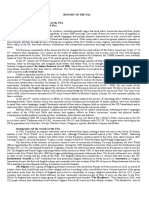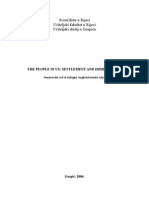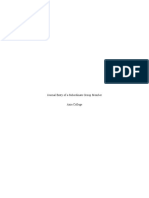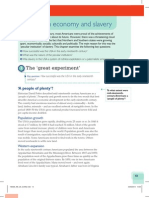Blade 04-17-14 01
Blade 04-17-14 01
Uploaded by
bladepublishingCopyright:
Available Formats
Blade 04-17-14 01
Blade 04-17-14 01
Uploaded by
bladepublishingOriginal Title
Copyright
Available Formats
Share this document
Did you find this document useful?
Is this content inappropriate?
Copyright:
Available Formats
Blade 04-17-14 01
Blade 04-17-14 01
Uploaded by
bladepublishingCopyright:
Available Formats
Tue.
April 15
Mostly Sunny
38/28
Wed. April 16
Snow/Wind
32/19
Thur. April 17
Partly Cloudy
41/24
Fri. April 18
Partly Cloudy
43/27
Sat. April 19
Partly Cloudy
50/32
Sun. April 20
Partly Cloudy
59/38
WEEKLY WEATHER REPORT
A community newspaper serving Browerville, MN and surrounding areas. USPS 067-560
Thursday, April 17, 2014
Volume 98; Number 41
www.bladepublishing.net
staff@bladepublishing.net
Ethnic Groups in Minnesota: What our ancestors faced
and what current immigrants confront
Part III: The Mexicans
A good day for the annual Mens Ham Dinner
By Rin Porter
In this story, we continue our
series on Minnesotas ethnic
groups of immigrants, and what
each group faced as people left
their home places and came to the
U.S. The migrations began in the
1600s and continue today.
BACKGROUND
From fewer than 6,100 people in
1850, Minnesota's population grew
to over 1.75 million by 1900. Each
of the next six decades saw a 15%
rise in population, reaching 3.41
million in 1960. Growth then
slowed, rising to 3.8 million in
1970, and to 4.91 million in the
2000 census. As of July 1, 2009, the
state's population was estimated
at 5,266,214 by the U.S. Census
Bureau <http://en.wikipedia.
org/wiki/U.S._Census_Bureau> .
The Constitution placed no
restrictions on immigration. In
fact, the new country needed more
people to work - clearing land for
farms, building roads, cutting lum-
ber, and growing food.
Millions of people emigrated from
Europe between 1776 and 1890.
The first U.S. law limiting
immigration was the Page Act of
1875. It prohibited immigrants
who were considered undesirable
from entering the U.S. The law
classified as "undesirable" any
individual from Asia
<http://en.wikipedia.org/wiki/Asia
> who was coming to America to
be a forced laborer
<http://en.wikipedia.org/wiki/Unfr
ee_labour>, any Asian woman who
would engage in prostitution
<http://en.wikipedia.org/wiki/Prost
itution>, and all people considered
to be convicts
<http://en.wikipedia.org/wiki/Conv
ict> in their own country
(Wikipedia).
Additional laws passed in 1906,
1907, 1917, 1918, 1921, and 1924
established more restrictions on
immigration: making some knowl-
edge of English a requirement for
citizenship, further restricting
immigration from Asia and includ-
ing a reading test, restricting the
immigration from a given country
to 3% of the number of people from
that country living in the U.S. in
1910, and freezing the 1924 ethnic
distribution in response to rising
immigration from Southern and
Eastern Europe, as well as Asia,
and introducing quotas.
In the first article in this series
on immigration, we examined the
German-speaking people who
formed the largest group to come to
America and to come to Minnesota.
In the second article, we consid-
ered the Polish people who came
from an area close by the German-
speaking areas, and sometimes
overlapping them in Central
Europe.
In this third article, we study
the experiences of Mexicans.
HISTORY OF MEXICO
Before Columbus, the conti-
nents of North and South America
were populated by millions of
native people, who formed thou-
sands of tribes. The tribes lived
throughout the vast area of the
Western Hemisphere, from the tip
of South America to the Arctic
Circle of North America. Some
were hunter-gatherers, some were
agriculturalists, and some were
both. These tribes had complex
religious and social systems, as we
know from archaeological studies
of the ruins of buildings created by
the Maya, Aztec, Toltec, Mixtec,
Olmec, and many other civiliza-
tions that were based in Central
and South America.
Before Columbus, explorers
from areas we now know as
Scandinavia, France, and the
Netherlands had rowed and sailed
boats to Greenland and northern
Canada, trading with the native
people there, but never trying to
It was a cold, blustery Sunday afternoon for the Annual Mens Ham Dinner held at Christ
the King Church on April 13th.
A large number of friends and family members helped Topsy
May celebrate her 80th birthday at the Browerville
Community Center on April 12th.
Easter Church
Services
Christ the King Catholic
Church - Browerville
St. Josephs Catholic Church - Clarissa
St. Josephs Catholic Church - Bertha
Holy Thursday Evening Mass of the Lords Supper,
April 17 7:30 p.m. at Christ the King &Adoration until
10:00 p.m.
Good Friday Celebration of the Lords Passion, April 18
12:00 p.m. at Christ the King, Browerville
3:00 p.m. at St. Josephs, Clarissa
Holy Saturday Easter Vigil, April 19,
8:00 p.m. at Christ the King, Browerville
Easter Sunday Masses, April 20,
7:30 a.m. at Christ the King, Browerville
9:00 a.m. at St. Josephs, Clarissa
11:00 a.m. at St. Josephs, Bertha
Zion Lutheran Church - Browerville
Holy Thursday Service, April 17, 7:00 pm
Good Friday Service, April 18, 1:00 pm
Easter Sunday Services, April 20, 7:00 am & 10:00 am
A breakfast will be served between services
Rose City Evangelical Free Church -
Eagle Bend
16241 County Rd 14 NE
218-943-4241
Good Friday Service with Communion, April 18, 6:30
pm
Easter Sunday Service-Celebrate the Good of God
through the Resurrection Story, April 20, 10:45 am
You might also like
- Memorandum of Agreement (Doctor)Document2 pagesMemorandum of Agreement (Doctor)Kisler Cortes100% (17)
- The Great Evil: Christianity, the Bible, and the Native American GenocideFrom EverandThe Great Evil: Christianity, the Bible, and the Native American GenocideNo ratings yet
- FORM 2B - Word FormatDocument6 pagesFORM 2B - Word FormatKannan Muthusamy100% (1)
- Ellis Island: Tracing Your Family History Through America's GatewayFrom EverandEllis Island: Tracing Your Family History Through America's GatewayRating: 3.5 out of 5 stars3.5/5 (2)
- 5 Million Indigenous Americans Present When Columbus ArrivedDocument5 pages5 Million Indigenous Americans Present When Columbus ArrivedNuqman Tehuti El100% (7)
- The Truth About Thanksgiving Updated (The 400th Year Anniversary of The Mayflower Compact)Document11 pagesThe Truth About Thanksgiving Updated (The 400th Year Anniversary of The Mayflower Compact)Timothy100% (1)
- Lee Inner Dikes OrientalsDocument19 pagesLee Inner Dikes OrientalsmynameiswutNo ratings yet
- Latino Americans: The 500-Year Legacy That Shaped a NationFrom EverandLatino Americans: The 500-Year Legacy That Shaped a NationRating: 4 out of 5 stars4/5 (4)
- History of The UsaDocument3 pagesHistory of The UsaEvelina MitruNo ratings yet
- Third Year Immigration From Late 19 Century To Early 20 CenturyDocument3 pagesThird Year Immigration From Late 19 Century To Early 20 CenturyRobin Scherbatsky100% (1)
- 01 1610 To 1933Document98 pages01 1610 To 1933Anthony ThorneNo ratings yet
- Debate Video SubtitleDocument13 pagesDebate Video SubtitleTham NguyenNo ratings yet
- Ethnic Minorities in The UsaDocument5 pagesEthnic Minorities in The UsaTīzīrī ĔşpiNo ratings yet
- The People in Us: Settlement and ImmigrationDocument14 pagesThe People in Us: Settlement and ImmigrationIvicaNo ratings yet
- Native American Genocide MythDocument8 pagesNative American Genocide MythMario Chalup100% (1)
- Charlie Chan Is Dead 2: At Home in the World (An Anthology of Contemporary Asian American Fiction-- Revised and Updated)From EverandCharlie Chan Is Dead 2: At Home in the World (An Anthology of Contemporary Asian American Fiction-- Revised and Updated)Rating: 3.5 out of 5 stars3.5/5 (6)
- Back To Back Meth Busts Result in Numerous ArrestsDocument12 pagesBack To Back Meth Busts Result in Numerous ArrestsbladepublishingNo ratings yet
- Estabrook - Tribe of IshmaelDocument7 pagesEstabrook - Tribe of IshmaelJahred Jedeye100% (1)
- James Loewen The Truth About The First ThanksgivingDocument5 pagesJames Loewen The Truth About The First ThanksgivingsNo ratings yet
- The Golden DoorDocument4 pagesThe Golden DoorloganzxNo ratings yet
- Ben Anderson - Western Nationalism and Eastern Nationalism PDFDocument12 pagesBen Anderson - Western Nationalism and Eastern Nationalism PDFendry02100% (1)
- Slavery in The USADocument5 pagesSlavery in The USAFlavio D'OnofrioNo ratings yet
- American PopulationDocument7 pagesAmerican PopulationjorisNo ratings yet
- I See The Rhythm of GospelDocument12 pagesI See The Rhythm of GospelZondervan100% (1)
- Making the White Man's West: Whiteness and the Creation of the American WestFrom EverandMaking the White Man's West: Whiteness and the Creation of the American WestNo ratings yet
- Polish ImmigrantsDocument97 pagesPolish ImmigrantsMarcelo Zamora100% (2)
- Keeping the Faith: Ordinary People, Extraordinary LivesFrom EverandKeeping the Faith: Ordinary People, Extraordinary LivesRating: 5 out of 5 stars5/5 (5)
- Journal EntryDocument6 pagesJournal Entrycleon77No ratings yet
- Senior Project Rough PaperDocument13 pagesSenior Project Rough Paperapi-510889656No ratings yet
- Reasons Why You Shouldn't Ignore Immigration HistoryDocument5 pagesReasons Why You Shouldn't Ignore Immigration HistorydonatasfeqNo ratings yet
- African American History SlaveryDocument3 pagesAfrican American History SlaveryPerla HouseNo ratings yet
- US History NotesDocument3 pagesUS History NotesNaqeebullah Haji AmanullahNo ratings yet
- History of the United States - - WikipediaDocument75 pagesHistory of the United States - - WikipediaAnirudh GargNo ratings yet
- Polish Immigrants (2004)Document97 pagesPolish Immigrants (2004)3t1990No ratings yet
- Salvation Through Slavery: Chiricahua Apaches and Priests on the Spanish Colonial FrontierFrom EverandSalvation Through Slavery: Chiricahua Apaches and Priests on the Spanish Colonial FrontierNo ratings yet
- CM 2 - The Important Events of The 19th CenturyDocument3 pagesCM 2 - The Important Events of The 19th CenturySimon BecquetNo ratings yet
- White Supremacy and Imperialism: A Dance Known As GlobalismDocument10 pagesWhite Supremacy and Imperialism: A Dance Known As GlobalismMichael Andrew WhiteNo ratings yet
- Sent MACN-MACHB-BZBT-R201820021 Native American This Contradicts The Out of Africa Published 2018Document27 pagesSent MACN-MACHB-BZBT-R201820021 Native American This Contradicts The Out of Africa Published 2018Byron Zahar BeyNo ratings yet
- A History The Construction of Race and RacismDocument14 pagesA History The Construction of Race and RacismAsma Chahed100% (1)
- Jewish Buenos Aires, 1890-1939: In Search of an IdentityFrom EverandJewish Buenos Aires, 1890-1939: In Search of an IdentityNo ratings yet
- 9781444156508Document20 pages9781444156508eibsourceNo ratings yet
- Narration 2Document2 pagesNarration 2Hala AlsafadiNo ratings yet
- Browerville Blade - 04/24/2014Document12 pagesBrowerville Blade - 04/24/2014bladepublishingNo ratings yet
- Blade - 01 02 14Document12 pagesBlade - 01 02 14bladepublishingNo ratings yet
- Extreme, Sustained Cold Weather Has Many Effects: Residents Learn Highway 71 Project DetailsDocument12 pagesExtreme, Sustained Cold Weather Has Many Effects: Residents Learn Highway 71 Project DetailsbladepublishingNo ratings yet
- Browerville Blade - 03/20/2014Document12 pagesBrowerville Blade - 03/20/2014bladepublishingNo ratings yet
- VFW Honor Guard Thankful For Generous Donations: Girls Season Comes To An EndDocument12 pagesVFW Honor Guard Thankful For Generous Donations: Girls Season Comes To An EndbladepublishingNo ratings yet
- Blade 04-10-14 01Document1 pageBlade 04-10-14 01bladepublishingNo ratings yet
- Blade - 01 30 14Document12 pagesBlade - 01 30 14bladepublishingNo ratings yet
- Ring Missing For 25 Years Returned To Crosby Ironton GraduateDocument12 pagesRing Missing For 25 Years Returned To Crosby Ironton GraduatebladepublishingNo ratings yet
- Chimney Fires Are Real: A True Story From The Owner of The BladeDocument12 pagesChimney Fires Are Real: A True Story From The Owner of The BladebladepublishingNo ratings yet
- Browerville Blade - 03/06/2014Document12 pagesBrowerville Blade - 03/06/2014bladepublishingNo ratings yet
- Honor Society Inducts New MembersDocument12 pagesHonor Society Inducts New MembersbladepublishingNo ratings yet
- Browerville Blade - 04/10/2014Document12 pagesBrowerville Blade - 04/10/2014bladepublishingNo ratings yet
- Blade 02-06-14 01Document1 pageBlade 02-06-14 01bladepublishingNo ratings yet
- Back To Back Meth Busts Result in Numerous ArrestsDocument12 pagesBack To Back Meth Busts Result in Numerous ArrestsbladepublishingNo ratings yet
- Browerville Blade - 04/03/2014 - Page 01Document1 pageBrowerville Blade - 04/03/2014 - Page 01bladepublishingNo ratings yet
- Blade 01-30-14 01Document1 pageBlade 01-30-14 01bladepublishingNo ratings yet
- Country Courier - 12/13/2013 - Page 01Document1 pageCountry Courier - 12/13/2013 - Page 01bladepublishingNo ratings yet
- Blade - 01 16 14Document12 pagesBlade - 01 16 14bladepublishingNo ratings yet
- Blade - 01 09 14Document12 pagesBlade - 01 09 14bladepublishingNo ratings yet
- Blade 01-09-14 01Document1 pageBlade 01-09-14 01bladepublishingNo ratings yet
- Blade 01-02-14 01Document1 pageBlade 01-02-14 01bladepublishingNo ratings yet
- Blade 01-16-14 01Document1 pageBlade 01-16-14 01bladepublishingNo ratings yet
- Browerville Blade - 12/26/2013Document16 pagesBrowerville Blade - 12/26/2013bladepublishingNo ratings yet
- Browerville Blade - 11/14/2013 - Page 01Document1 pageBrowerville Blade - 11/14/2013 - Page 01bladepublishingNo ratings yet
- Browerville Blade - 12/12/2013 - Page 01Document1 pageBrowerville Blade - 12/12/2013 - Page 01bladepublishingNo ratings yet
- Thanksgiving Explosion Rocks Browerville's Land O' Lakes PlantDocument1 pageThanksgiving Explosion Rocks Browerville's Land O' Lakes PlantbladepublishingNo ratings yet
- Browerville Blade - 12/12/2013Document12 pagesBrowerville Blade - 12/12/2013bladepublishingNo ratings yet
- Thanksgiving Explosion Rocks Browerville's Land O' Lakes PlantDocument12 pagesThanksgiving Explosion Rocks Browerville's Land O' Lakes PlantbladepublishingNo ratings yet
- Marital RapeDocument2 pagesMarital RapeLek TupiñoNo ratings yet
- BS en Iso 16890-2-2022Document3 pagesBS en Iso 16890-2-2022Marco0% (1)
- TaxDocument21 pagesTaxAnna Dela VegaNo ratings yet
- Lesson 4 The Cavite MutinyDocument10 pagesLesson 4 The Cavite MutinyEunice Ortile100% (2)
- Load LinesDocument6 pagesLoad LinesChaitu Un PrediCtbleNo ratings yet
- Deed of Trust - 1Document9 pagesDeed of Trust - 1Sandeep DuttaNo ratings yet
- Prezentare 28Document7 pagesPrezentare 28Oana SîrbuNo ratings yet
- TARA Constitution - FINALDocument10 pagesTARA Constitution - FINALandreworangeNo ratings yet
- Era Td-011rec1028 Esc-Rsc Technical Document enDocument23 pagesEra Td-011rec1028 Esc-Rsc Technical Document enLollo CarlNo ratings yet
- Jan Csec 2025 Registration InstructionsDocument6 pagesJan Csec 2025 Registration Instructionsakasteve2013No ratings yet
- OMT VISA Application FormDocument2 pagesOMT VISA Application Formdimitriosabboud1No ratings yet
- Chapter 16 in Belgian BrusselsDocument4 pagesChapter 16 in Belgian BrusselsRJ RianoNo ratings yet
- Eurotel at Vivaldi: Euro Towers International IncDocument29 pagesEurotel at Vivaldi: Euro Towers International IncReegan MasarateNo ratings yet
- CTA Case Filinvest Devt Corp V CIRDocument5 pagesCTA Case Filinvest Devt Corp V CIRsaintkarriNo ratings yet
- Abhishek Kumar...Document2 pagesAbhishek Kumar...Prince AbhiNo ratings yet
- RVOS2024120339Document1 pageRVOS2024120339rvos.rawabi52No ratings yet
- Pamantasan NG CabuyaoDocument2 pagesPamantasan NG CabuyaoHhhhhNo ratings yet
- 3M Fire Barrier Sealant CP 25WB+Document2 pages3M Fire Barrier Sealant CP 25WB+Reginald D. De GuzmanNo ratings yet
- In Re Letters of Estelito Mendoza Re GR No 178083 FASAP Vs PALDocument27 pagesIn Re Letters of Estelito Mendoza Re GR No 178083 FASAP Vs PALAnonymous 5k7iGyNo ratings yet
- 003-Megger - Insulation TesterDocument4 pages003-Megger - Insulation TesterAjlan Khan100% (1)
- Criminal Law NotesDocument10 pagesCriminal Law NotesmcamillefranciscoNo ratings yet
- Philippine Commercial and Industrial Bank, and Henares v. The Hon. Court of Appeals and Marinduque Mining and Industrial CorporationDocument1 pagePhilippine Commercial and Industrial Bank, and Henares v. The Hon. Court of Appeals and Marinduque Mining and Industrial CorporationCheCheNo ratings yet
- Paramaribos Inter-Colonial ConnectionsDocument29 pagesParamaribos Inter-Colonial ConnectionsSven EscaurizaNo ratings yet
- Acc030 Classification ExerciseDocument2 pagesAcc030 Classification ExerciseAqilahNo ratings yet
- 2 - Bir Ruling No. 517-11Document5 pages2 - Bir Ruling No. 517-11Gino Alejandro SisonNo ratings yet
- Engineering Mechanics SyllabusDocument2 pagesEngineering Mechanics SyllabusMeenakshi ChauhanNo ratings yet
- In 84 Guidelines For Selection and Employment of ConsultantsDocument11 pagesIn 84 Guidelines For Selection and Employment of ConsultantsESSNo ratings yet
- Kraft's Acquisition of Cadbury - An Ethical and Financial HighlightDocument11 pagesKraft's Acquisition of Cadbury - An Ethical and Financial HighlightLLM smk100% (1)




















































































































